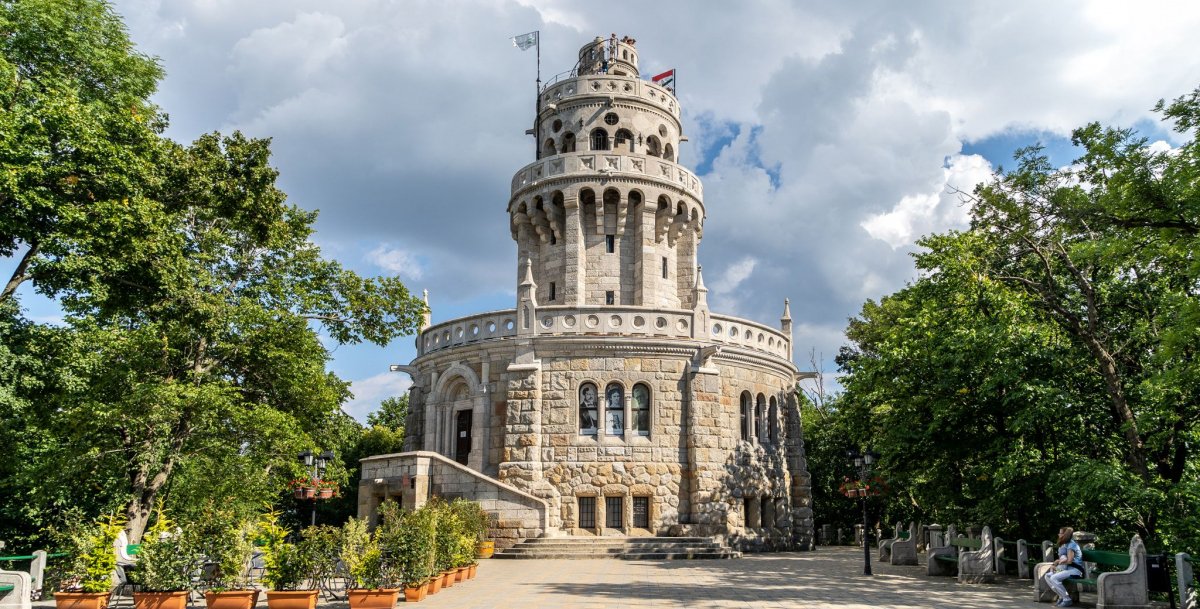The highest point of Budapest, the 529-meter-high János Hill, has been one of the most popular excursion destinations in the capital for centuries. It is well-known that Sisi, Franz Joseph's wife, also liked the area. A 1911 article in the Turisták Lapja says the hillside was “once and frequently visited by Queen Elizabeth to admire the panorama.” The tower was named in her honour 110 years ago when it was completed in 1910. To honour the anniversary, we completed the easy walk above the city.
From Normafa to János Hill
As a nature-loving resident of Budapest, we decided to start our trip at Normafa. Even while travelling on the bus, we noticed there were fewer passengers than usual. The fields held a similar feeling. At other times, larger crowds fill the area and children are greeted by running dogs.
Of course, many wish for the green forest to forget the hustle and bustle of the city. Yet, nature also seemed to breathe a little, not flooded with pedestrians, cyclists and roller skaters wandering off the trails.
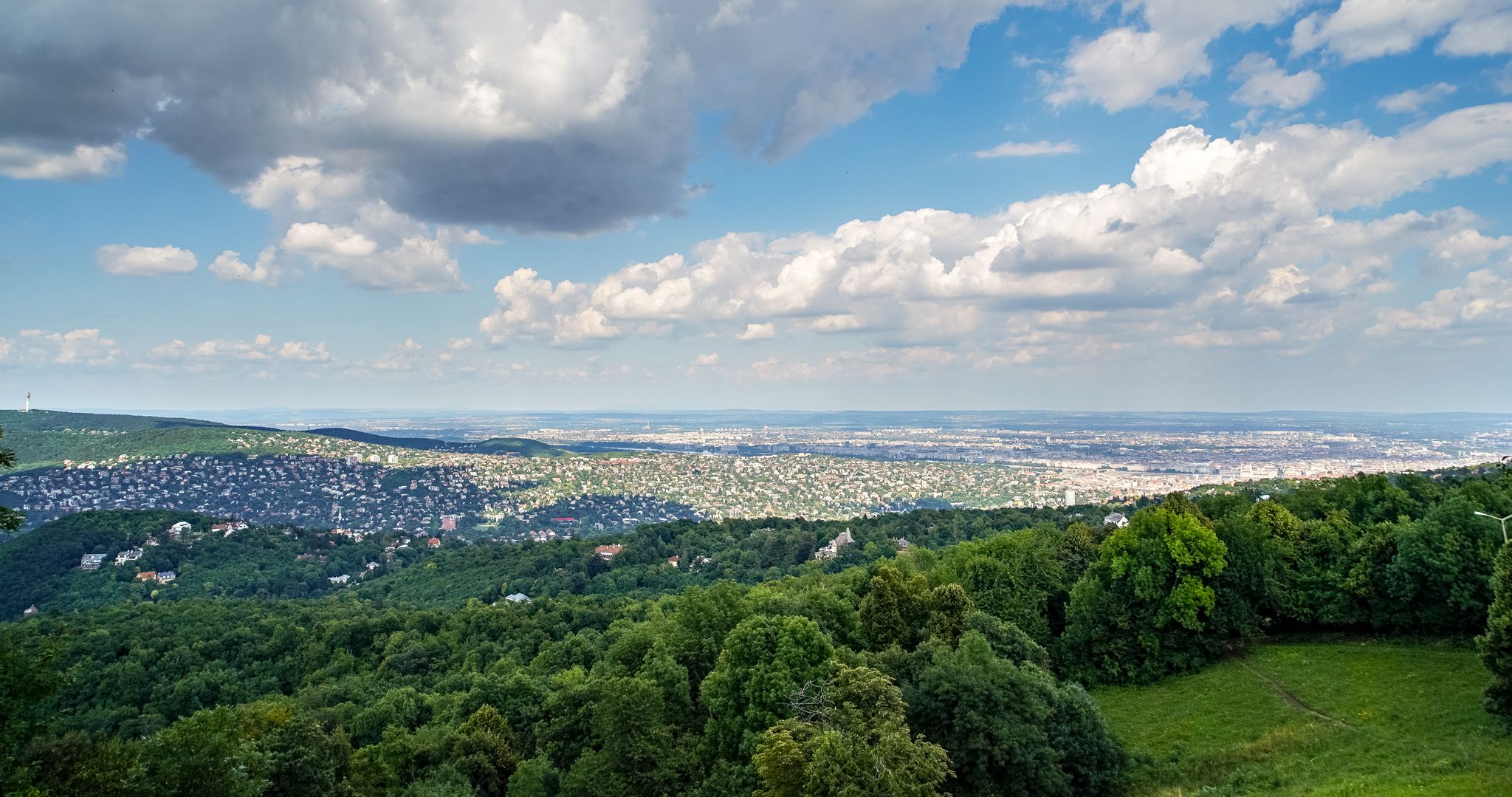
On the way to the Elizabeth Lookout Tower, the view from Normafa is worth a few minutes (Photo: Balázs Both/pestbuda.hu)
After admiring the magnificent view of the city below us at Normafa, we set off on the footpath towards the lookout. Even those on their first visit do not need a map, as the characteristic limestone tower stands out from afar among the green foliage.
Of course, we were not the only ones heading for János Hill. Along the way, we met some runners, Nordic walkers and dog walkers. Surprisingly, we found that only a negligible number of foreigners were among them, although before the outbreak of the epidemic, Normafa and János Hill were considered popular tourist destinations. Nevertheless, Anna Meadow did not disappoint. As usual, small and large companies cooked at the campfire sites, and families with children took possession of the playground and its surroundings.
But how did Queen Elizabeth visit János Hill and its surroundings? We got an answer to our question not long later.
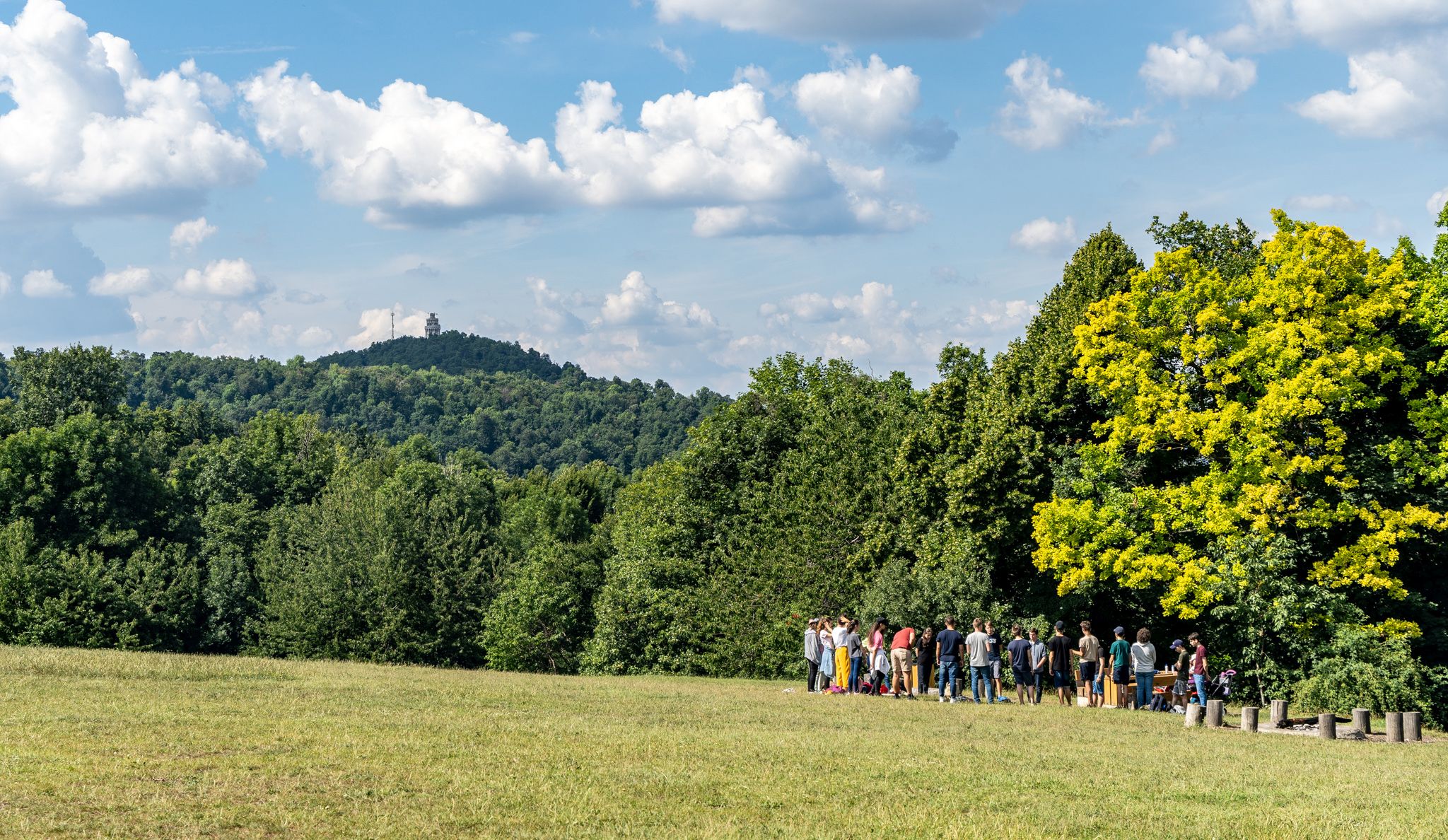
Looking over Anna meadow, the characteristic tower cannot be missed (Photo: Balázs Both/pestbuda.hu)
Although the trail leads through shady trees, where hikers are not exposed to the rays of the scorching sun, it got quite hot by the time we reached the terminus of the chair lift, so we decided to buy a cooling ice cream. We expected the line to meander in front of the buffet, but we were wrong. Only one family sat on the bench licking ice cream. It wasn’t long before we realized that the area around the chairlift was empty because it does not operate on weekdays.
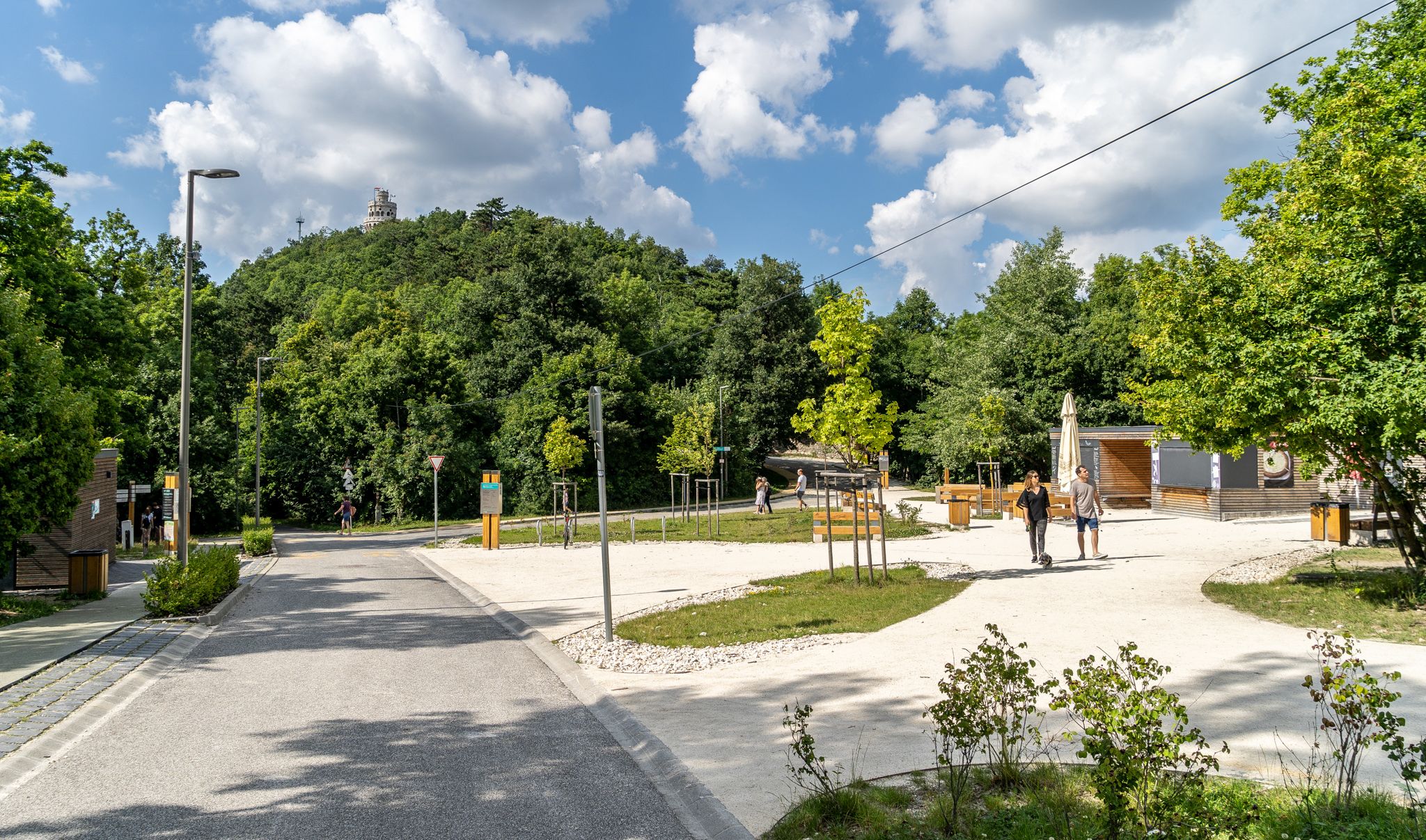
The Elizabeth Lookout Tower is nearby the top of the chairlift (Photo: Balázs Both/pestbuda.hu)
A generous donation from hotel owners
After a short rest, we renewed our efforts for the last climb of János Hill. Although this was not the first time we had taken this walk, we still stood in front of the Elizabeth Lookout for minutes and admired the harmony of the building. At first glance, the lookout looks like a result of a careful designer’s work, which is both very practical and unparalleled aesthetic.
While city leaders wanted to see a monumental building on top of the hill to pay tribute to the memory of Queen Elizabeth, the work of Paul Klunzinger and Frigyes Schulek resulted in an architectural masterpiece that takes considers its environment and blends into it nicely.
The Turisták Lapja wrote about how the designers achieved this in 1911: “The appearance of the tower is considered to have the same effect from all sides due to its cylindrical nature. Due to the strong fragmentation of the body, the shape is just as favourable from a closer point of view, only the lovingly thought-out details harmoniously connect the defiant wall masses and thus enhance the effect.”
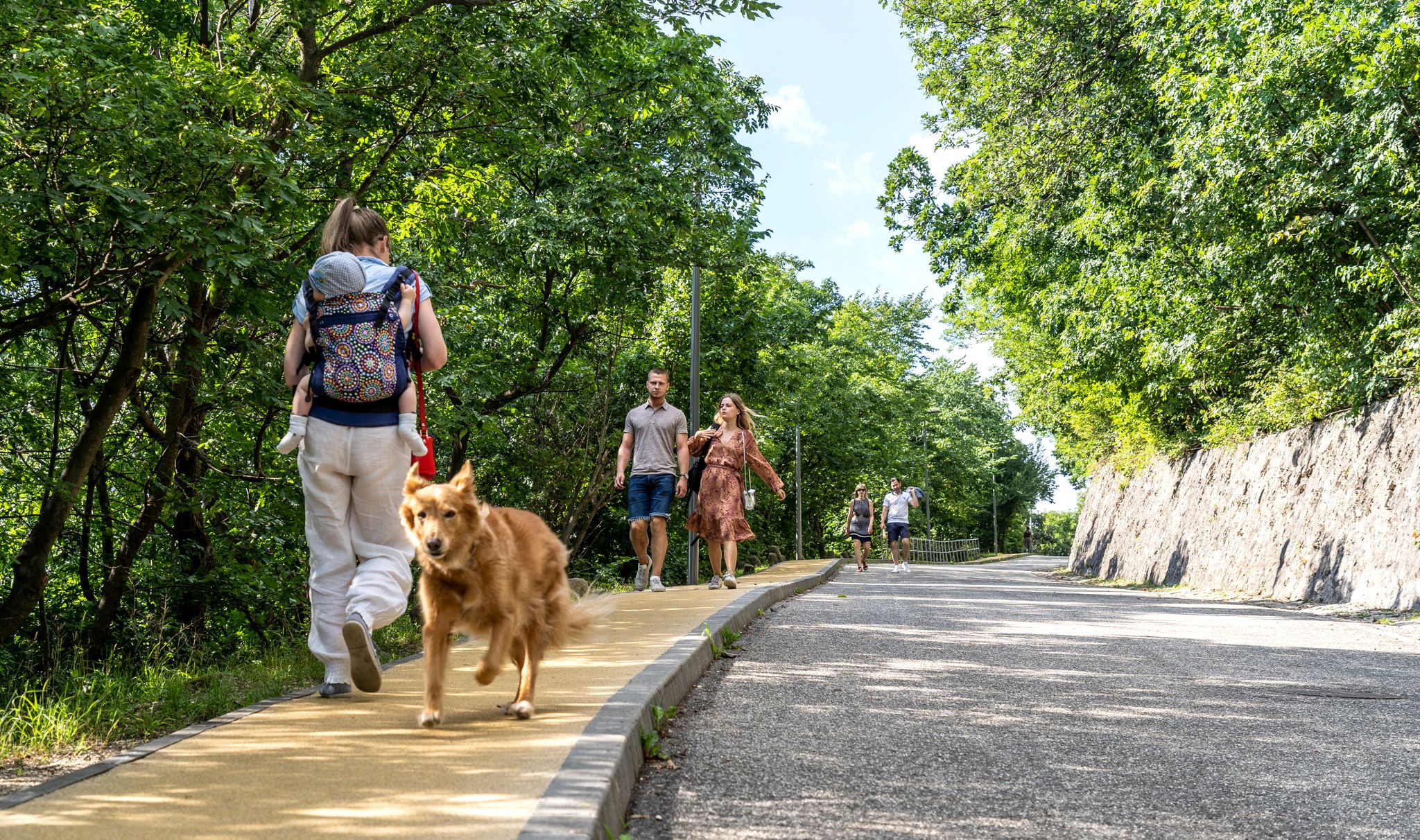
The road to the lookout leads up a steep slope (Photo: Balázs Both/pestbuda.hu)
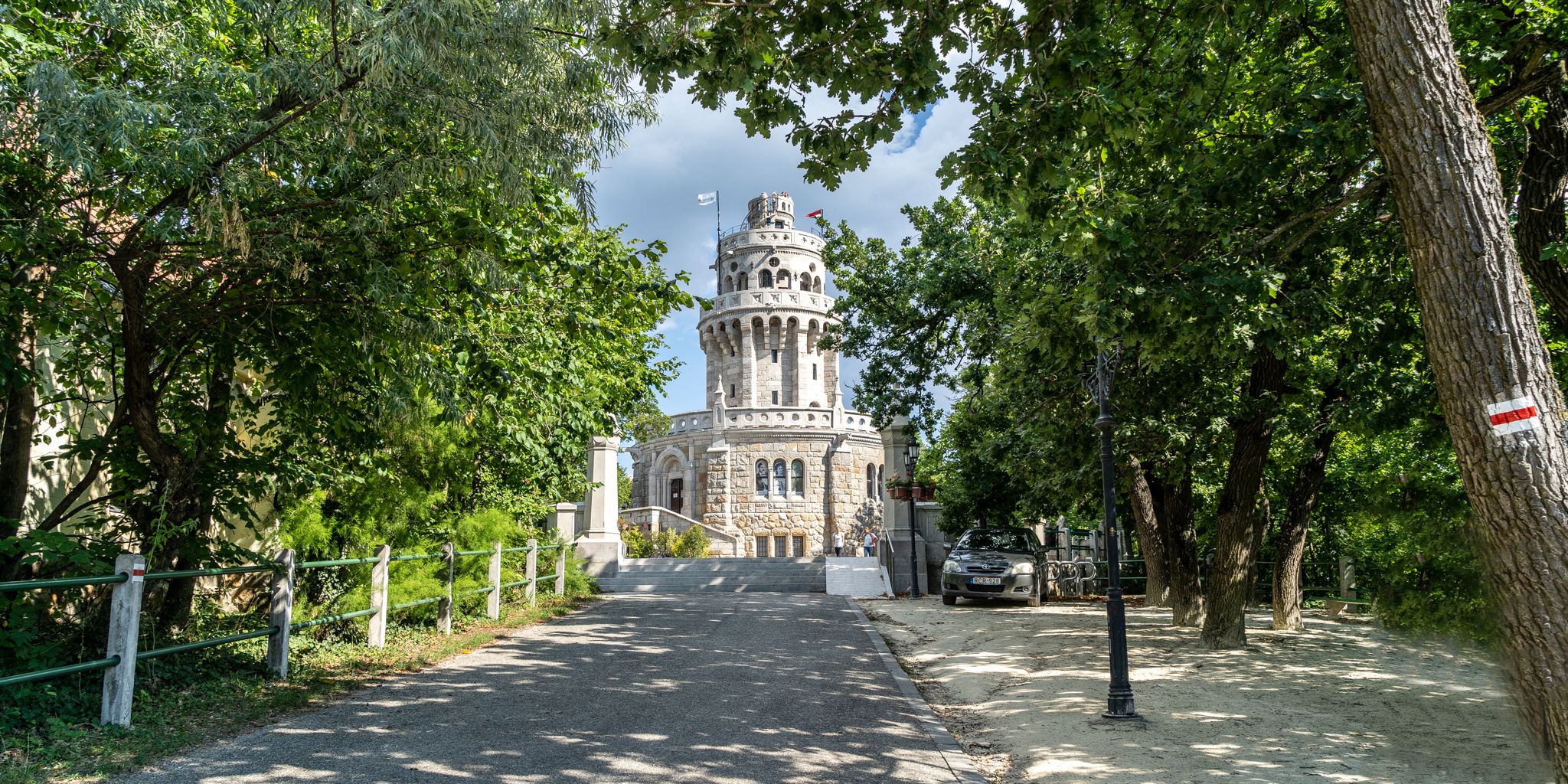
Thanks to the cylindrical shape of the tower, the view is similar from all sides (Photo: Balázs Both/pestbuda.hu)
But how does Sisi come into the picture? One of the favourite rulers of the Hungarians visited János Hill several times in 1882 to look at the city from a wooden lookout. As early as 1885, it was suggested that the lookout at that time should be replaced with a more lasting structure. A year later, "the Budapest Department of the Hungarian Tourist Association sent the city council a memo requesting a stone lookout instead of the wooden frame. The need for a new lookout tower was expressed from more and more sides.
The final push for the case was given by the International Hotel Congress held in Budapest in 1902. As part of the event, the participants also visited János Hill. At the time, hotel owner Frigyes Glück, who was a good friend of the mayor János Halmos, presented the plan of the new building to those present and donated a significant amount for its construction. Following the donation, Frigyes Glück organized a fundraiser in the association of members of the congress and Budapest innkeepers, as a result of which he collected 53,000 crowns which he handed over to János Halmos.

The lookout tower would not have been built without the generous donation offered by Frigyes Glück (Photo: Balázs Both/pestbuda.hu)
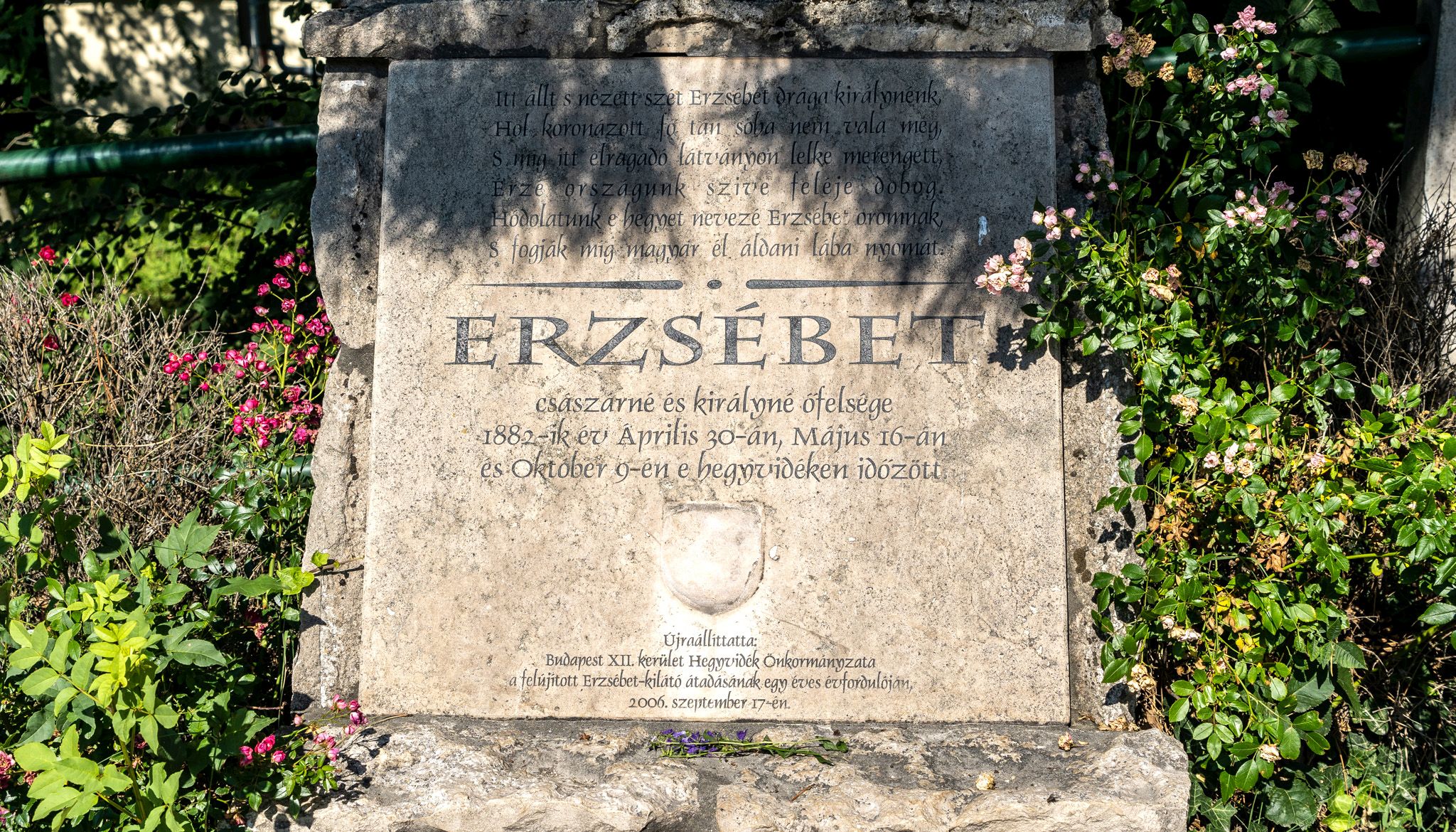
A memorial plaque was erected in honour of the namesake of the tower, Queen Elizabeth's visit (Photo: Balázs Both/pestbuda.hu)
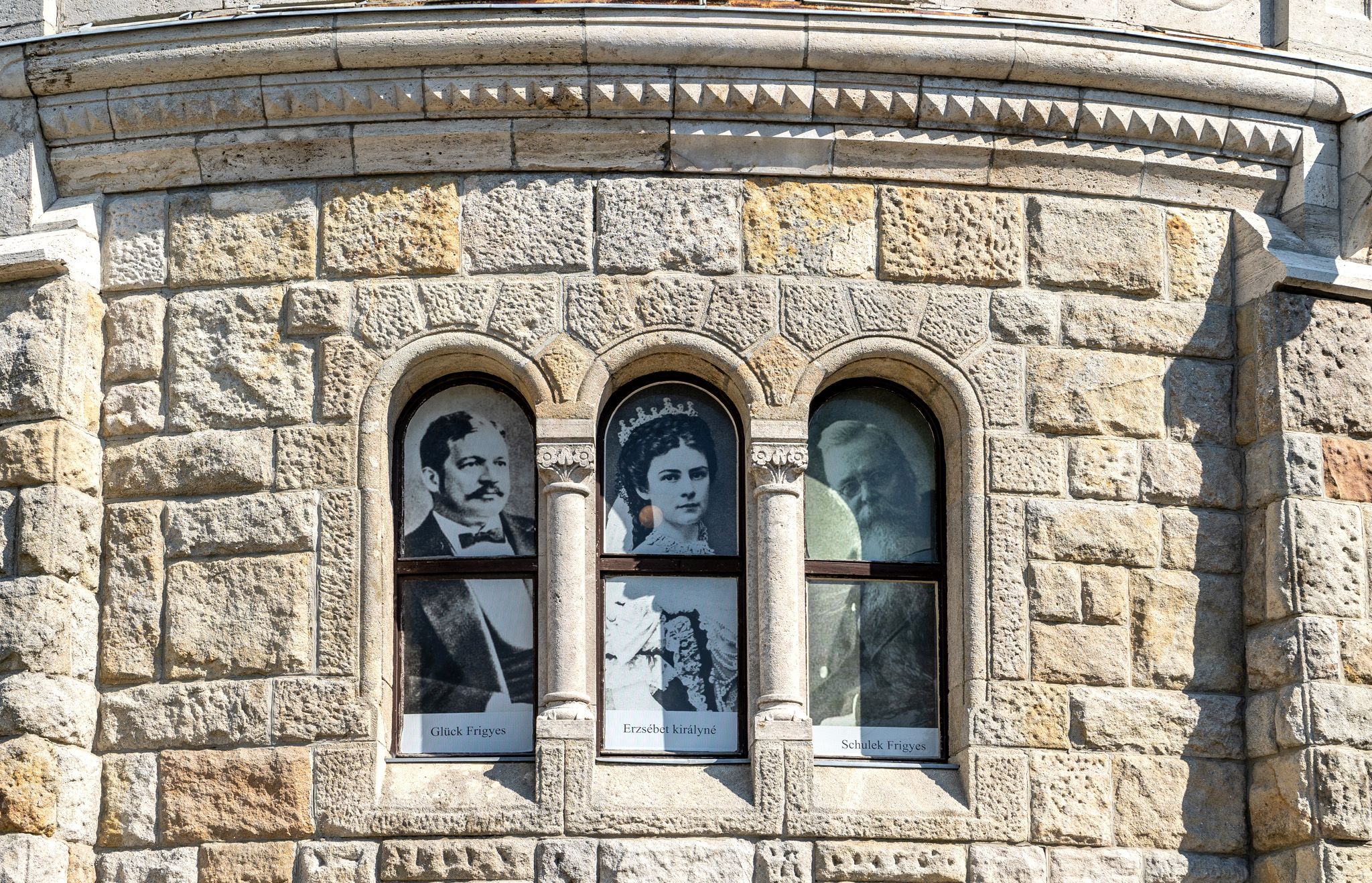
Photos also showcase the origins of the tower (Photo: Balázs Both/pestbuda.hu)
A dream come true
In 1904, the city leadership managed to raise the remaining amount needed to build the building. Although they originally wanted to announce a tender for the design of the lookout, which would have been judged by Frederick Schulek, this idea was eventually rejected due to time constraints. The mayor commissioned the capital’s engineering office to do the work. The first plans had been rejected earlier because they were too similar to other Western European lookouts and did not conform to the shape of the mountain. Finally, in 1906, Pál Klunzinger came up with a sketch to which Frigyes Schulek gave his theoretical consent.
Then they also prepared the budget, which kicked in at a total of 180 thousand crowns. The city, therefore, had to supplement the donations with 127,000 crowns. Finally, “On 7 June 1908, in the presence of representatives of the capital and the press, the first mound of earth was turned and the hard work of construction began, and apart from half-year breaks for the winter months, continued uninterrupted until 8 September 1910, the day the tower was opened."
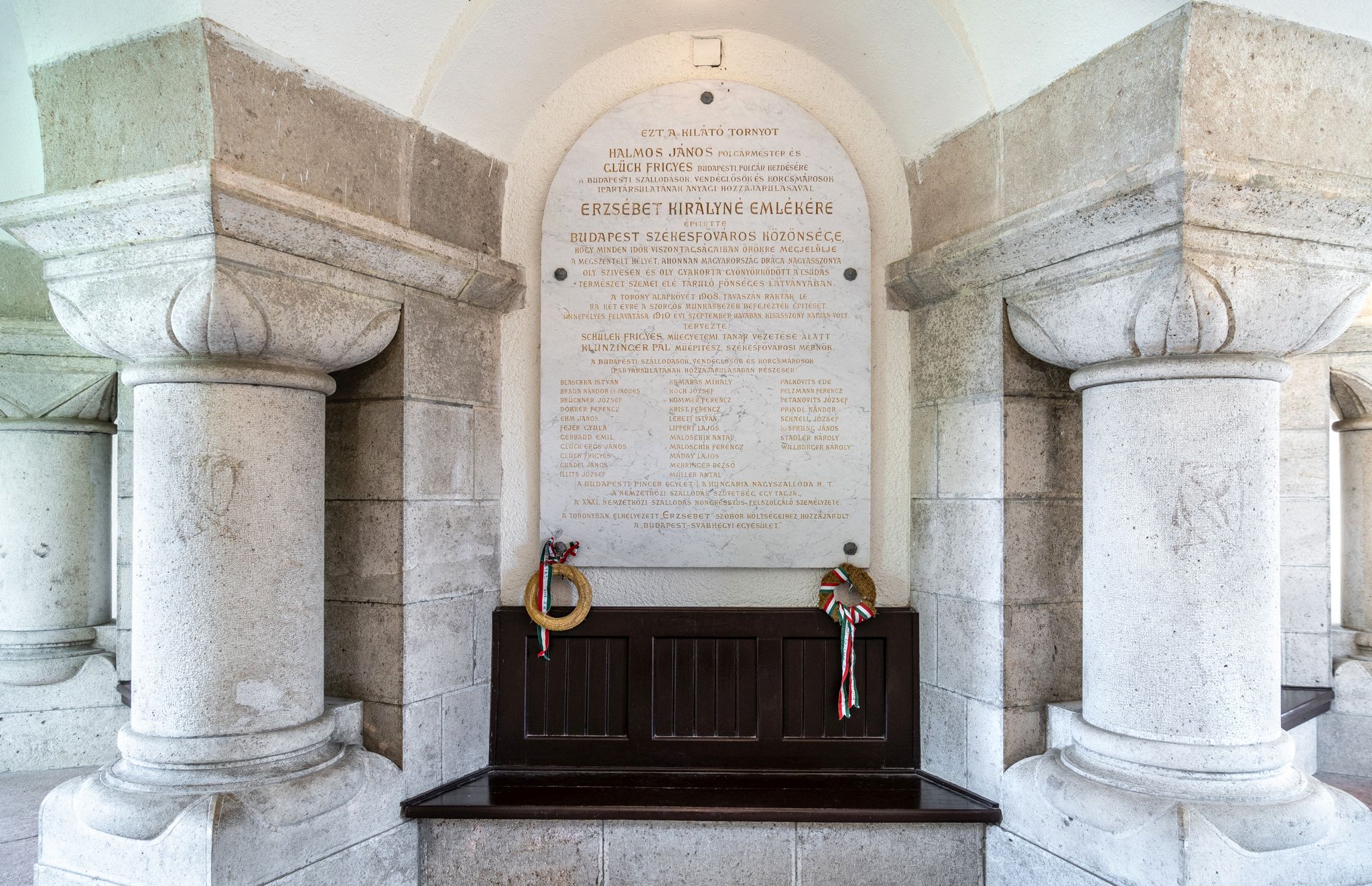
A memorial plaque reminds visitors of the opening of the lookout tower 110 years ago (Photo: Balázs Both/pestbuda.hu)
Only natural stone was used to cover the tower: Pilisborosjenő sandstone for the lower part, Budakalász limestone for the upper part. The lower floor was built of unevenly surfaced, barely worked, irregularly shaped blocks of rock, while the upper floor was made of regularly carved, finely worked, layered stones.
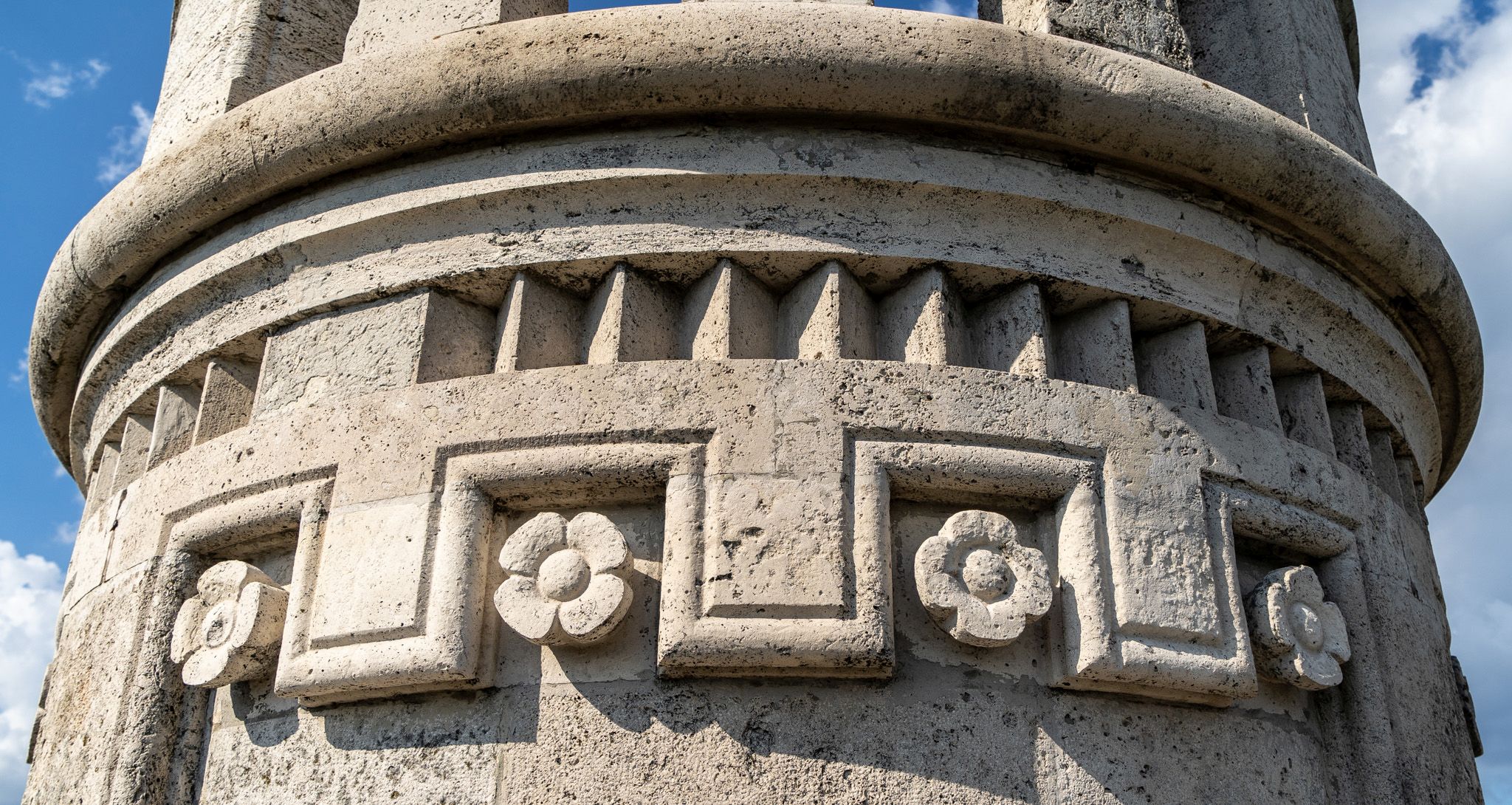
The lower part of the tower was covered with sandstone, the upper part with limestone (Photo: Balázs Both/pestbuda.hu)
However, the costs did not stop at the originally planned 180,000 crowns. Schulek changed the plans during construction. The tower would have originally had a conical roof. He proposed creating two terraces instead of a conical roof in order to make better use of space while preserving the artistic value. Although it was difficult to convince the authorities of the changes, which resulted in an additional cost of 60,000 crowns, the city eventually accepted the proposal.
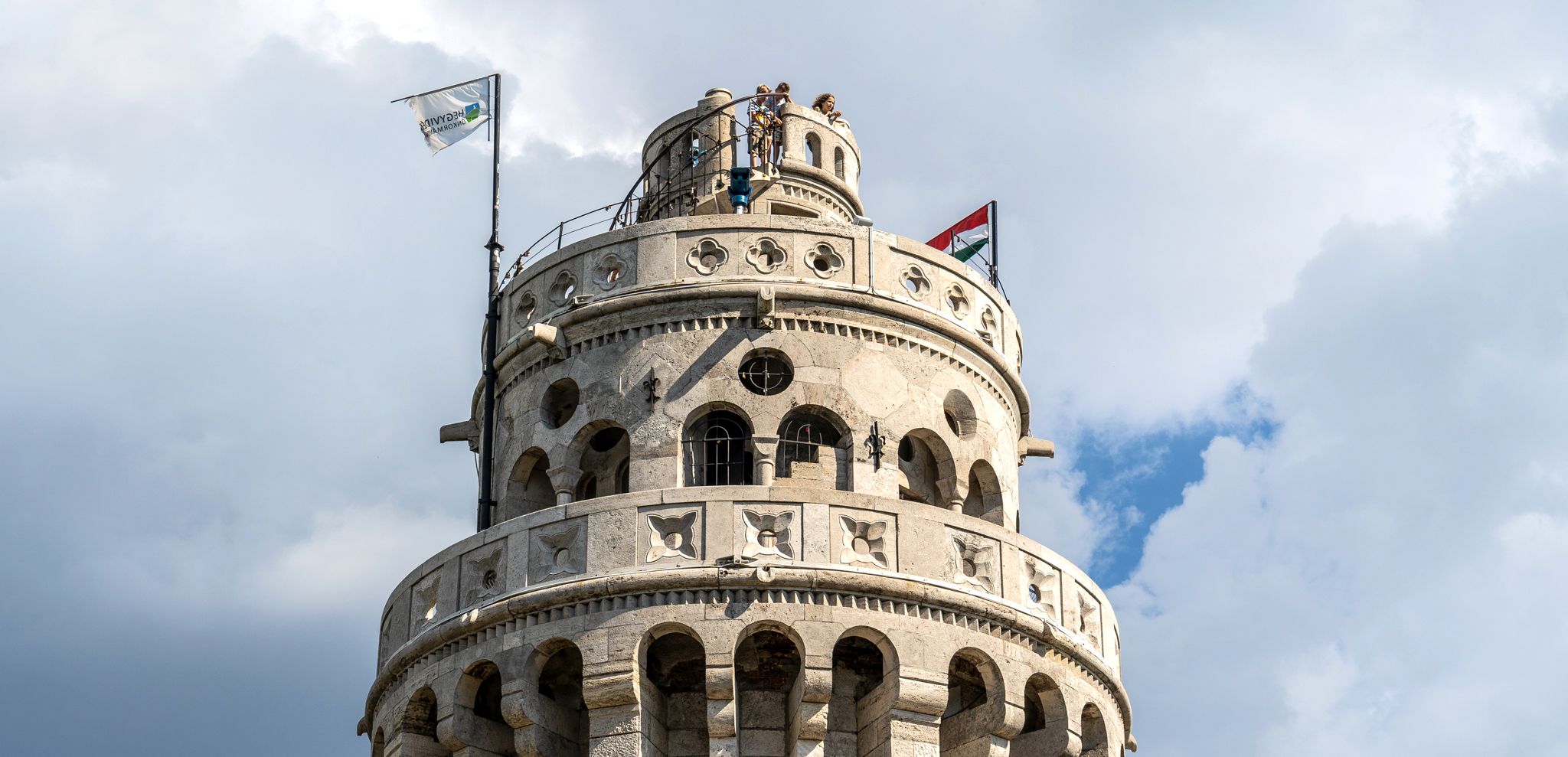
The tower would have originally ended in a conical roof, but two terraces were created instead (Photo: Balázs Both/pestbuda.hu)
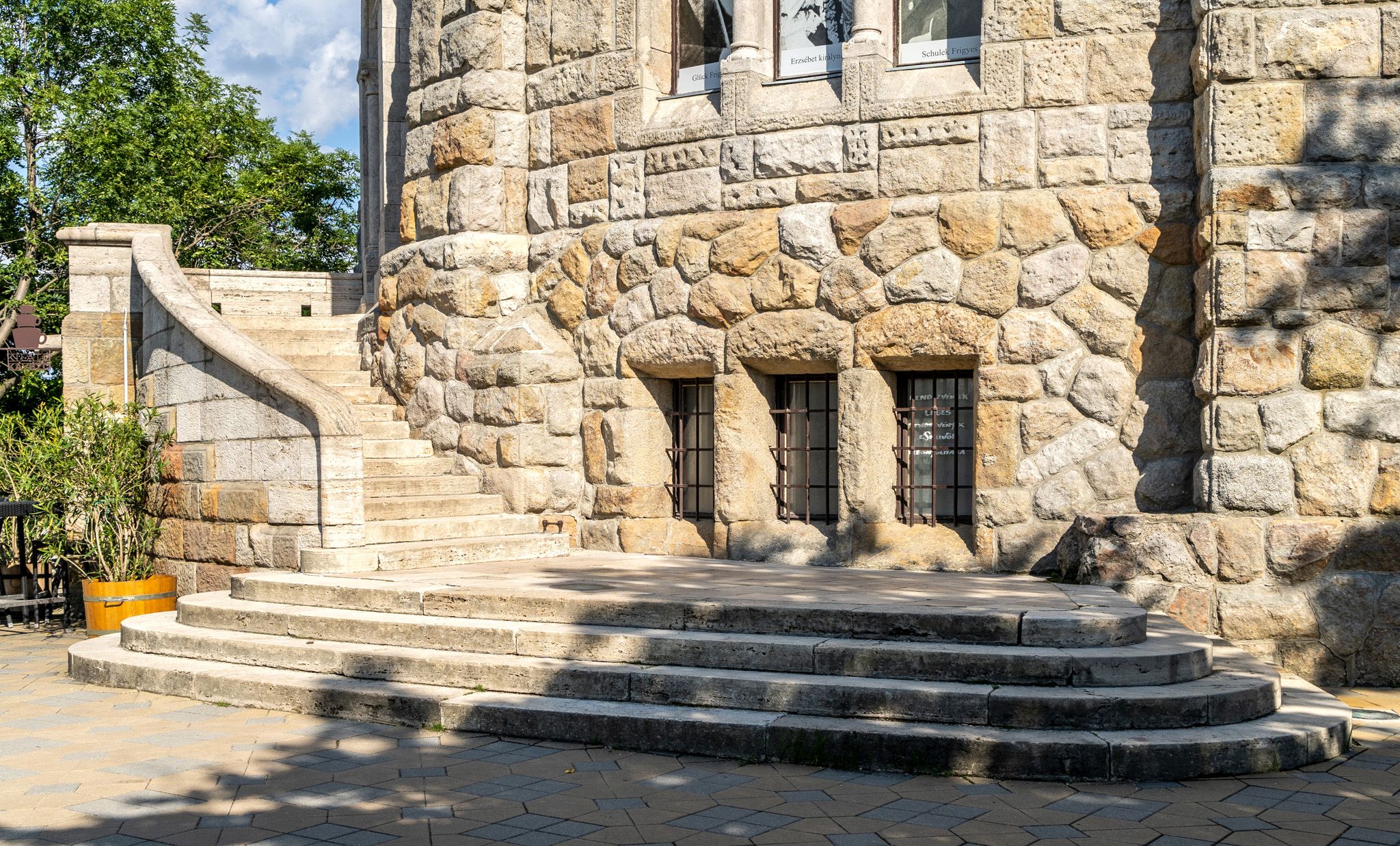 Start: 134 steps to climb (Photo: Balázs Both/pestbuda.hu)
Start: 134 steps to climb (Photo: Balázs Both/pestbuda.hu)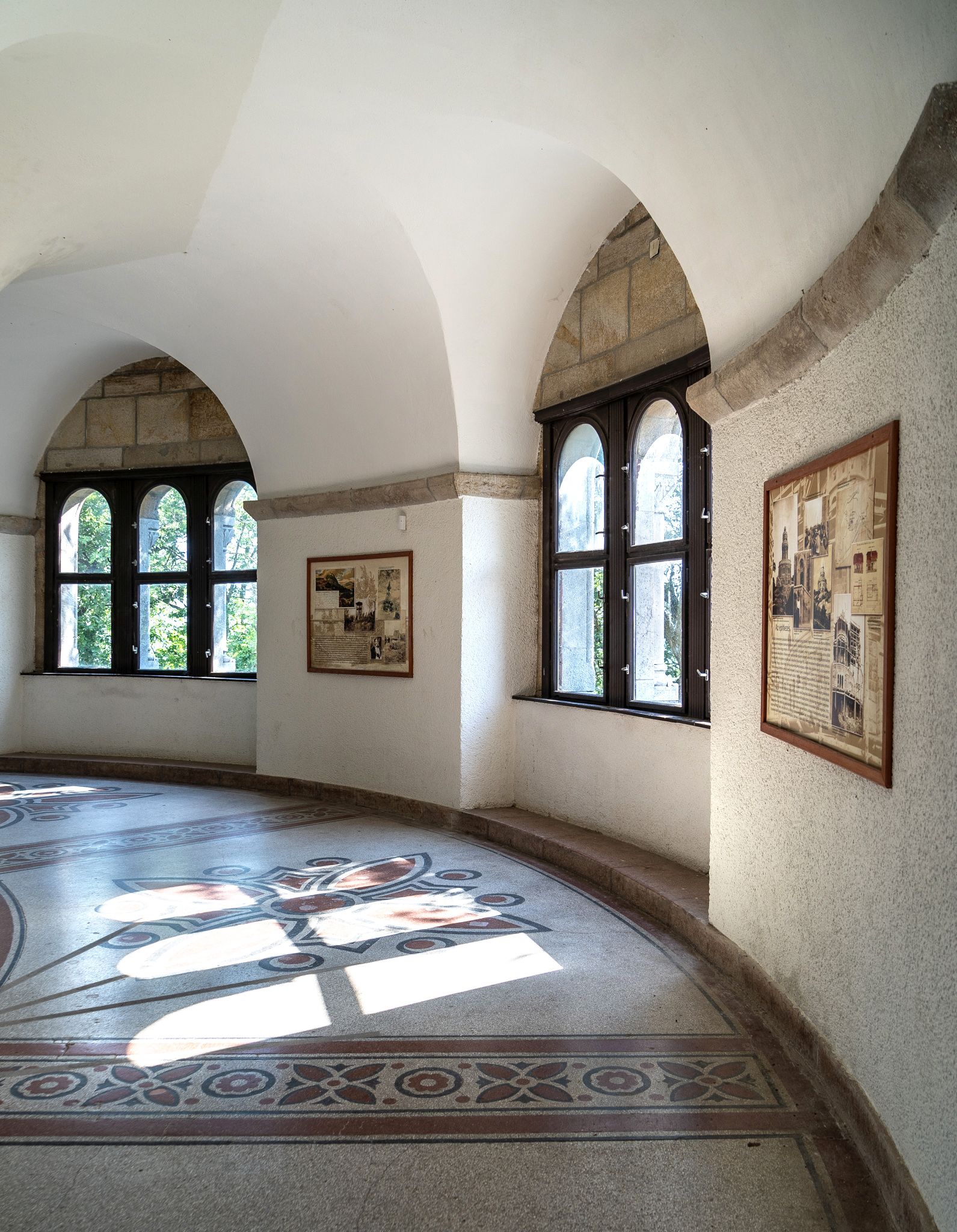
An exhibition about the building in the interior (Photo: Balázs Both/pestbuda.hu)
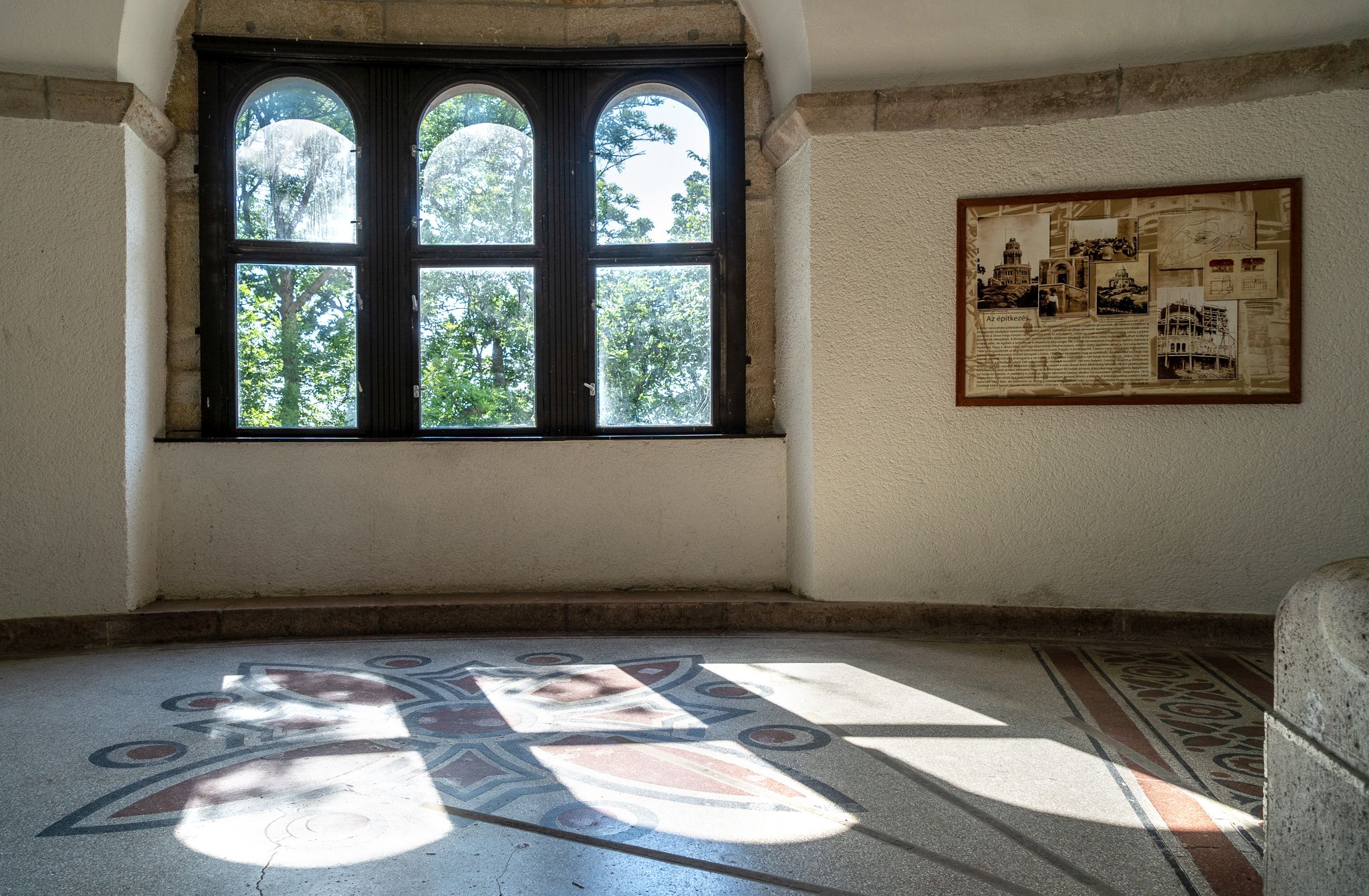 The windows and pavings are unique (Photo: Balázs Both/pestbuda.hu)
The windows and pavings are unique (Photo: Balázs Both/pestbuda.hu)
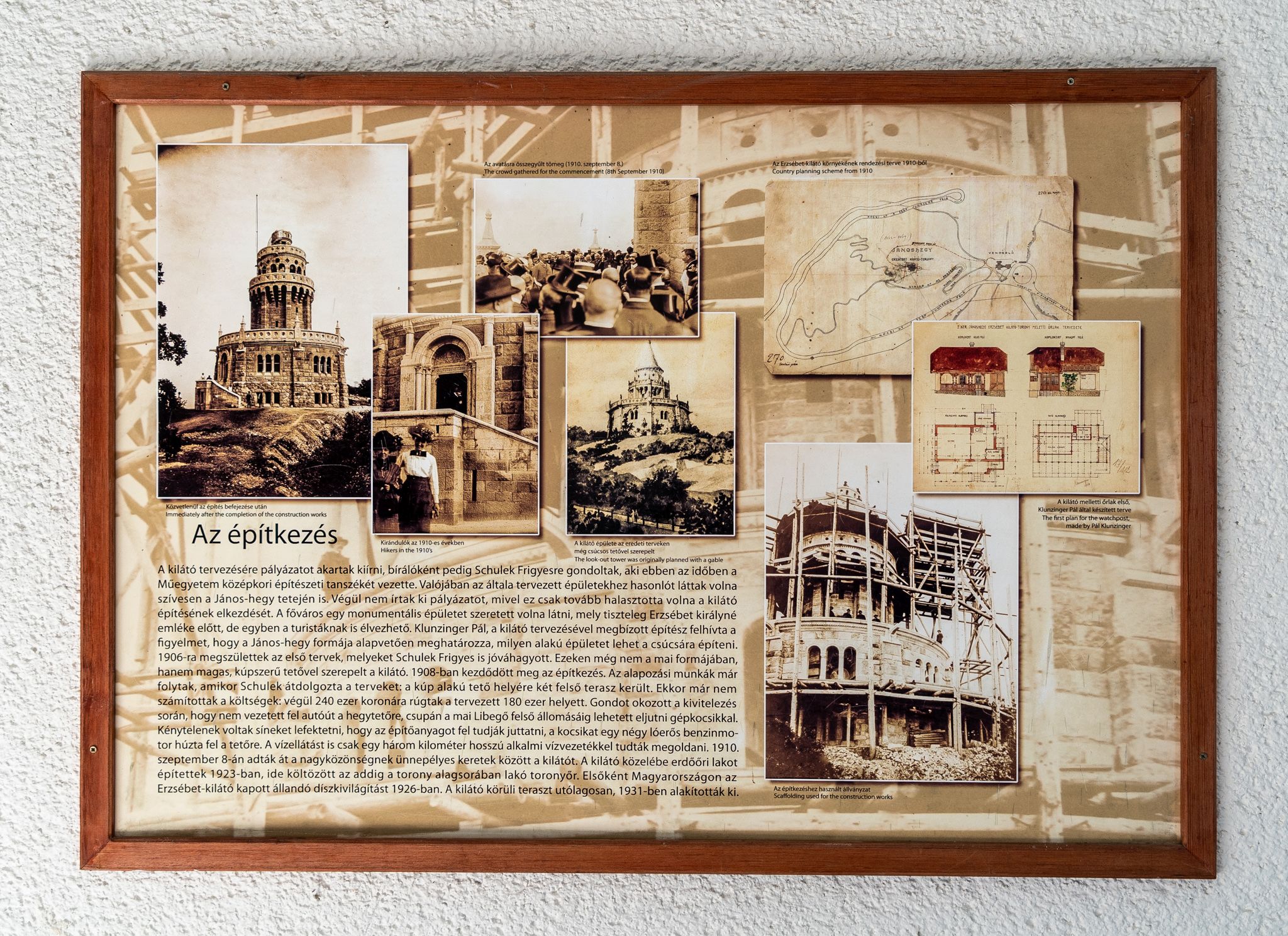 It's best to read everything carefully (Photo: Balázs Both/pestbuda.hu)
It's best to read everything carefully (Photo: Balázs Both/pestbuda.hu)
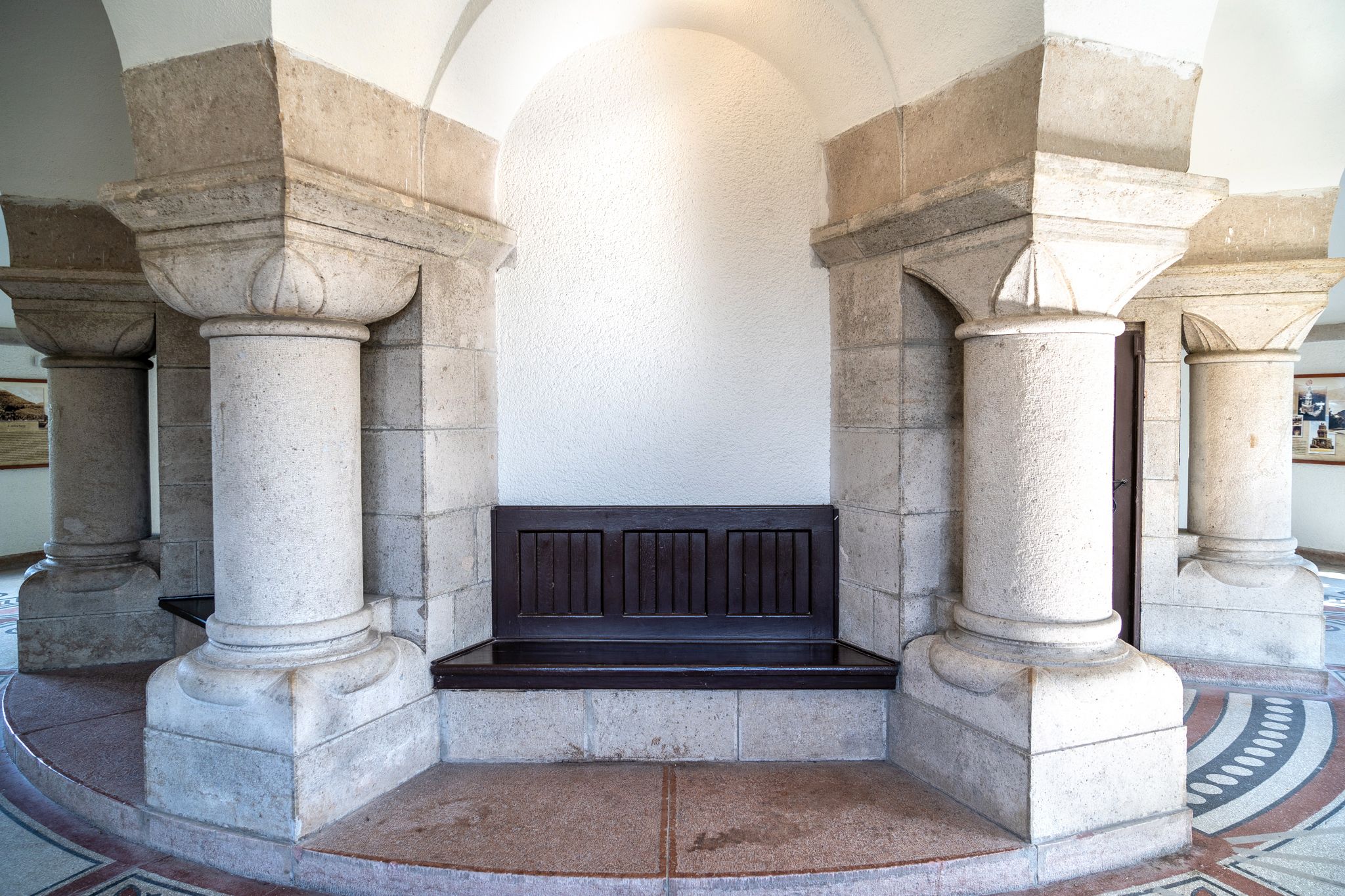 Everything needed for relaxation (Photo: Balázs Both/pestbuda.hu)
Everything needed for relaxation (Photo: Balázs Both/pestbuda.hu)
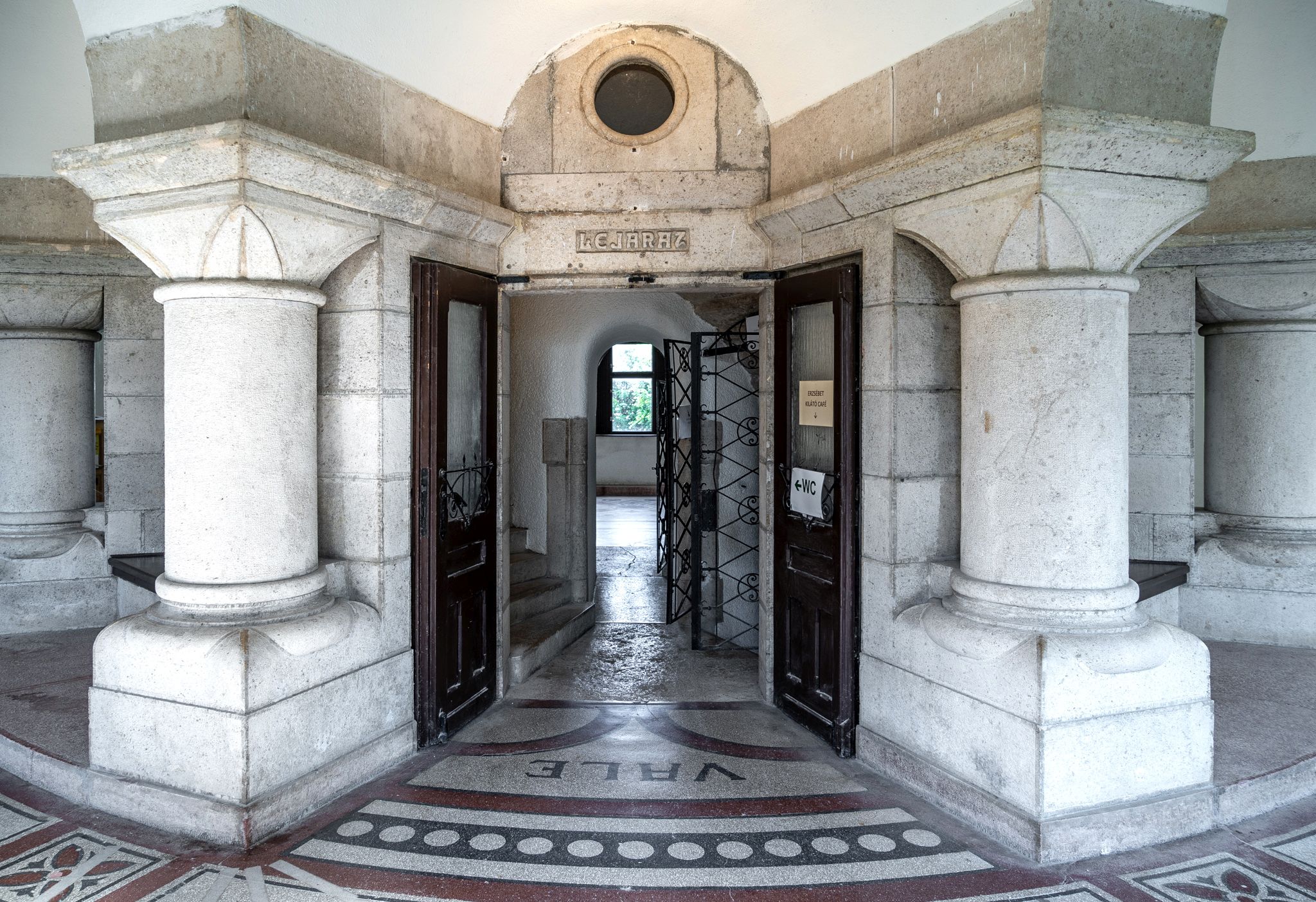 Frigyes Schulek designed an impressive building (Photo: Balázs Both/pestbuda.hu)
Frigyes Schulek designed an impressive building (Photo: Balázs Both/pestbuda.hu)
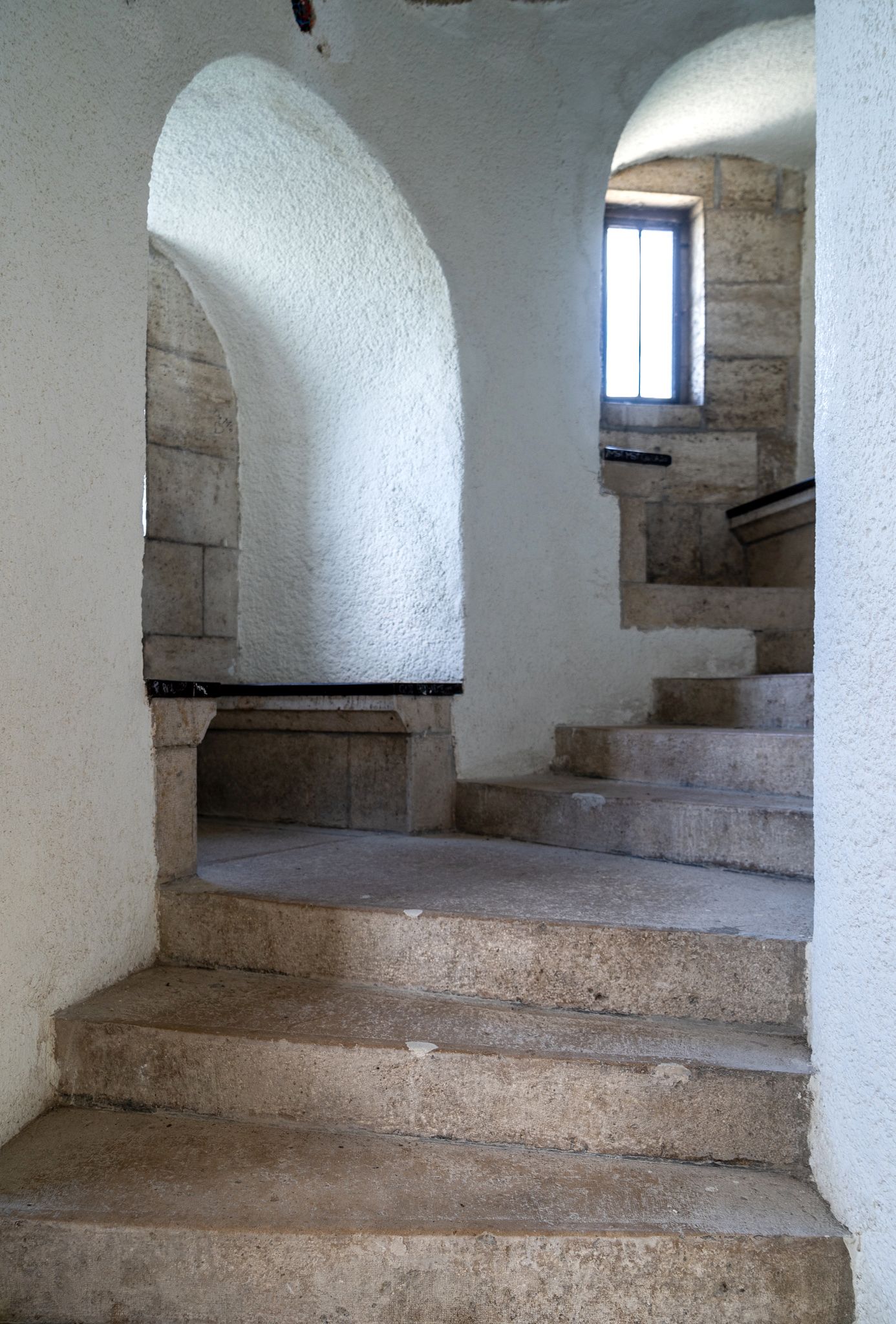
No problem here (Photo: Balázs Both/pestbuda.hu)
 Those who get tired can relax on the benches in the windows (Photo: Balázs Both/pestbuda.hu)
Those who get tired can relax on the benches in the windows (Photo: Balázs Both/pestbuda.hu)
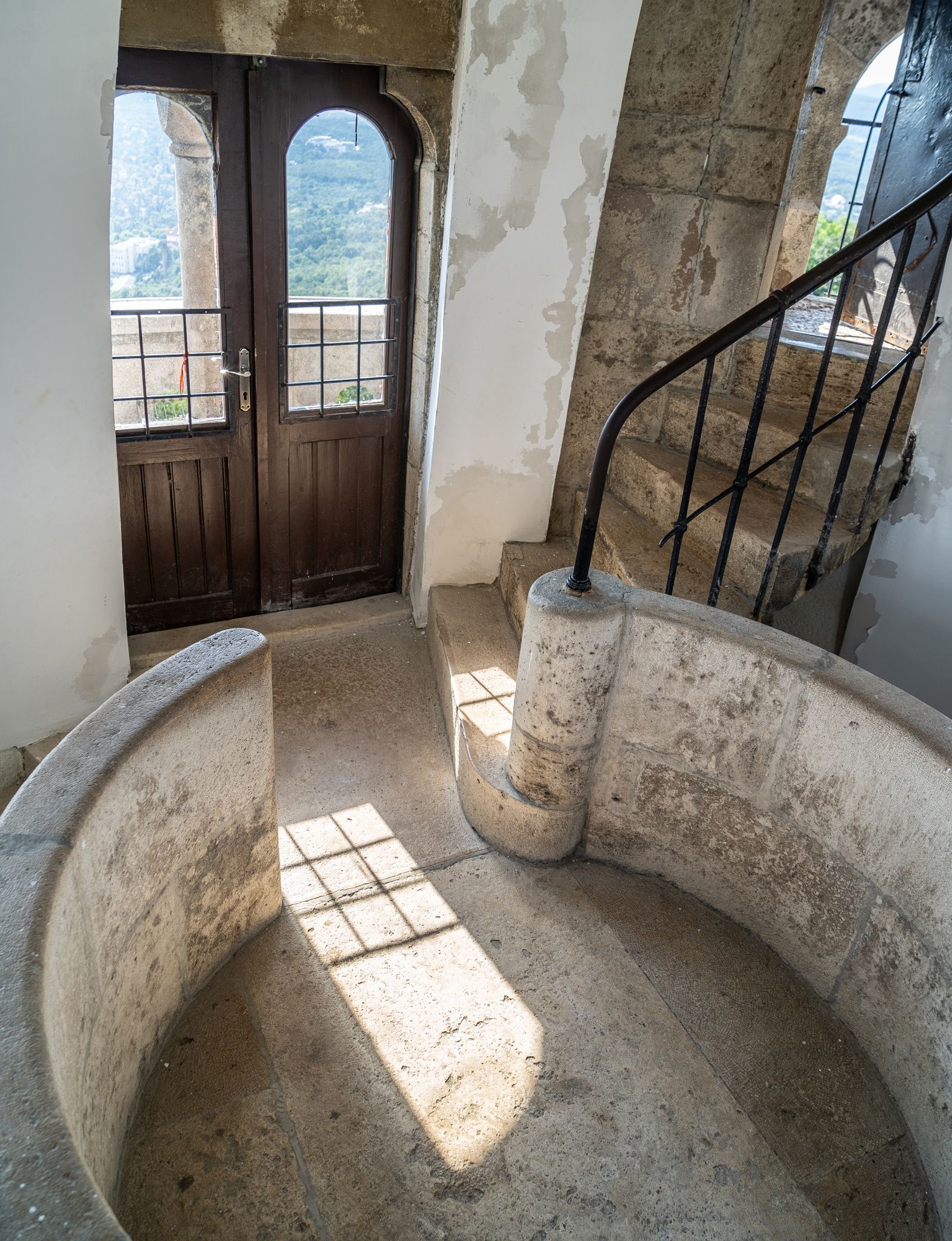 The panorama from the lower terrace is impressive (Photo: Balázs Both/pestbuda.hu)
The panorama from the lower terrace is impressive (Photo: Balázs Both/pestbuda.hu)
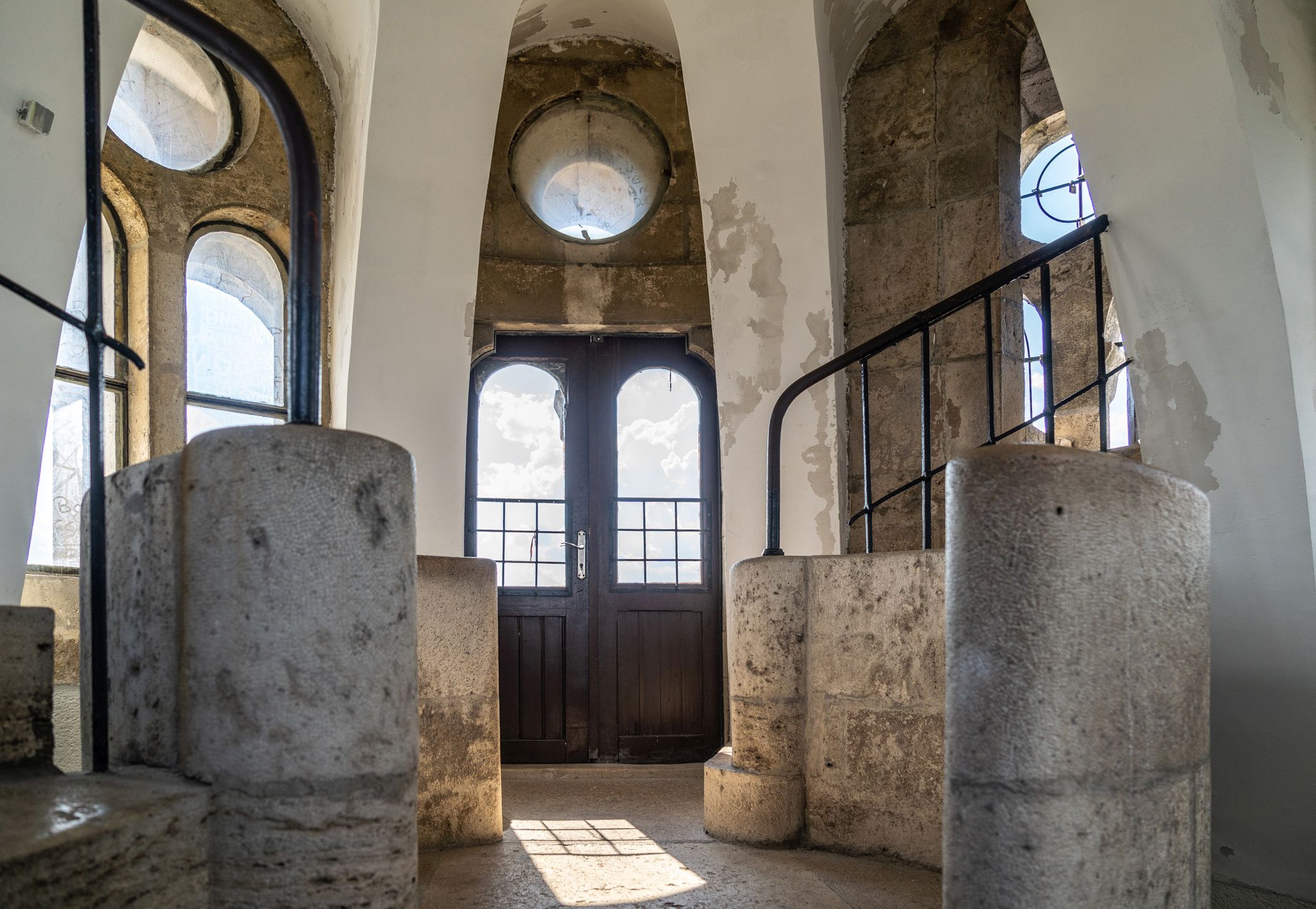 The light flowing through the doors and windows illuminates the interior wonderfully (Photo: Balázs Both/pestbuda.hu)
The light flowing through the doors and windows illuminates the interior wonderfully (Photo: Balázs Both/pestbuda.hu)
 The city from a special point of view (Photo: Balázs Both/pestbuda.hu)
The city from a special point of view (Photo: Balázs Both/pestbuda.hu)
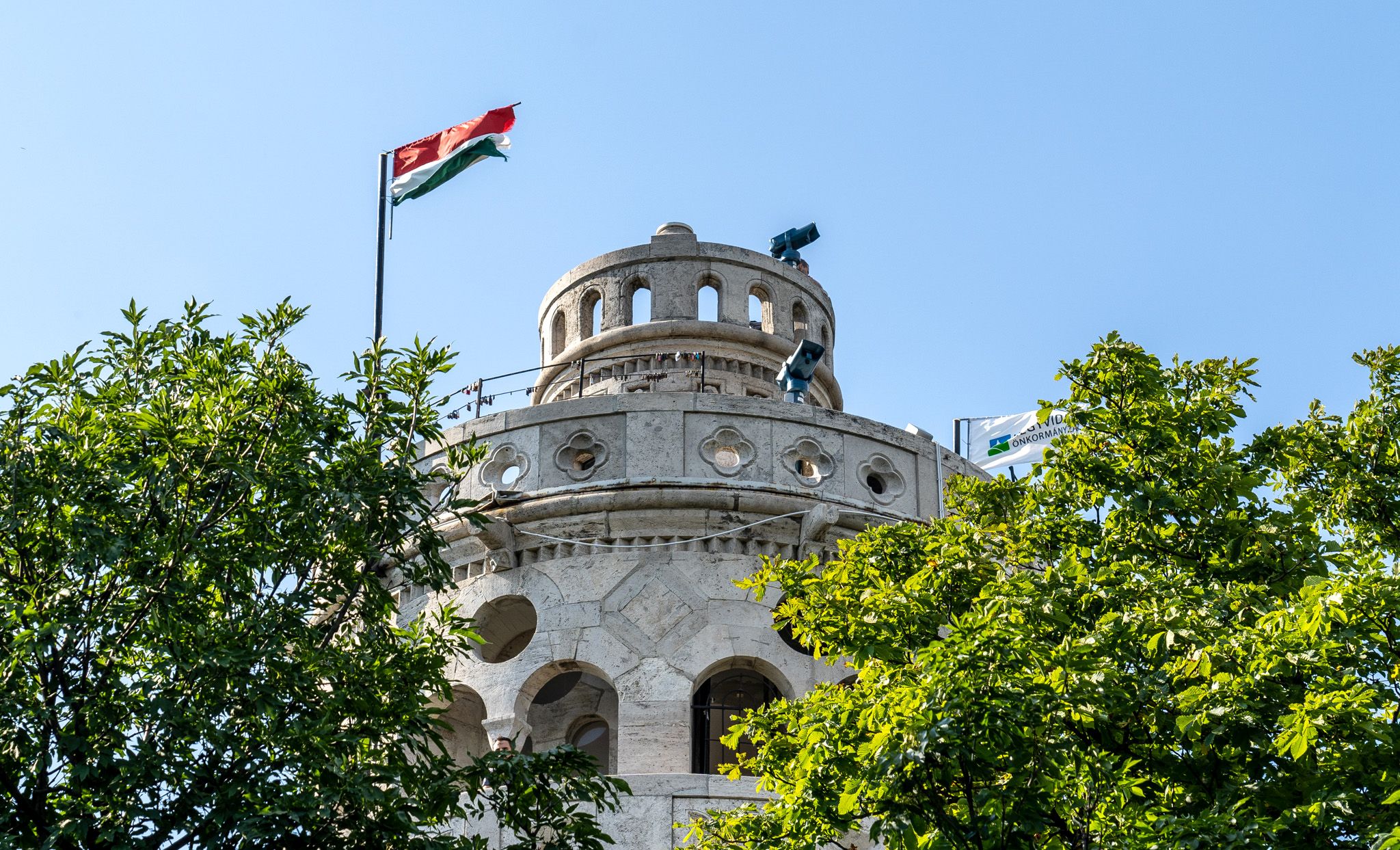
Hungarian flag fluttering on top of the building (Photo: Balázs Both/pestbuda.hu)
Unique panorama
Whether we admired the view from the lower or upper terrace, we agreed that the modification was a brilliant idea. The weather was clear, offering views into the distance. The sight was stunning: to the southeast, the Great Plain stretched in front of us to the cities of Cegléd and Dunaföldvár. To the southwest, we recognized the outlines of Törökbálint, Biatorbágy and Székesfehérvár with Lake Velence. To the west, Budakeszi and Páty, as well as the Vértes Hills, to the north-west, Nagykovácsi and Nagy-Szénás Hill.
To the north of us, the peaks of the Pilis rose. To the northeast, Rózsadomb and Hármashatár Hill. To the east, we were greeted by the view of the Mátra and the Bükk. This view covers a circle with a radius of about 75 kilometres. In good conditions, visitors can even see the High Tatra. According to contemporary data, the peaks of the mountains were first seen in 1900 by Hugó Hermann, former director of the Komprach ironworks.
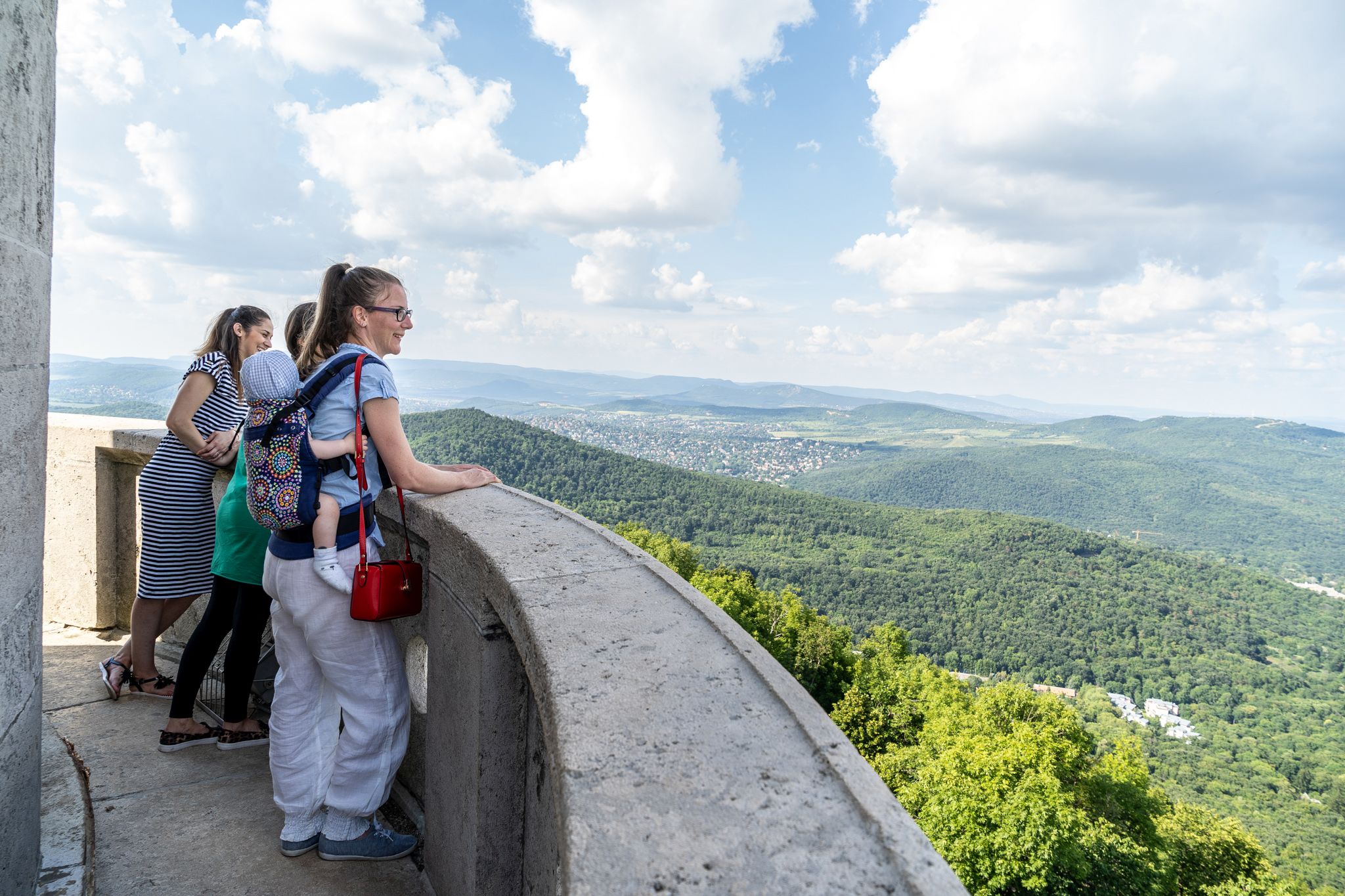
Tourists and the journalist of pestbuda.hu are happy to enjoy the breathtaking view (Photo: Balázs Both/pestbuda.hu)
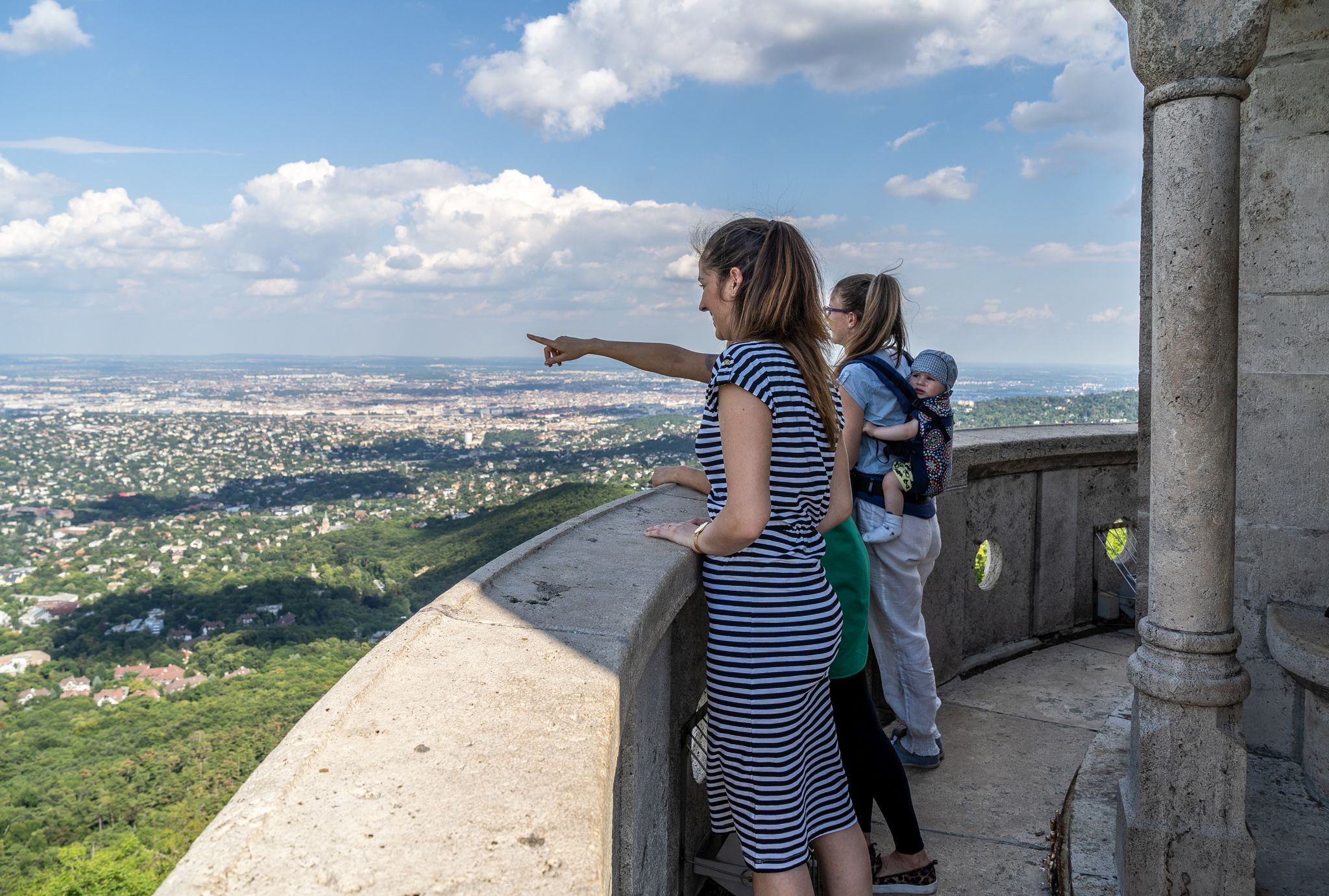
In clear weather, lucky visitors can see the High Tatras (Photo: Balázs Both/pestbuda.hu)
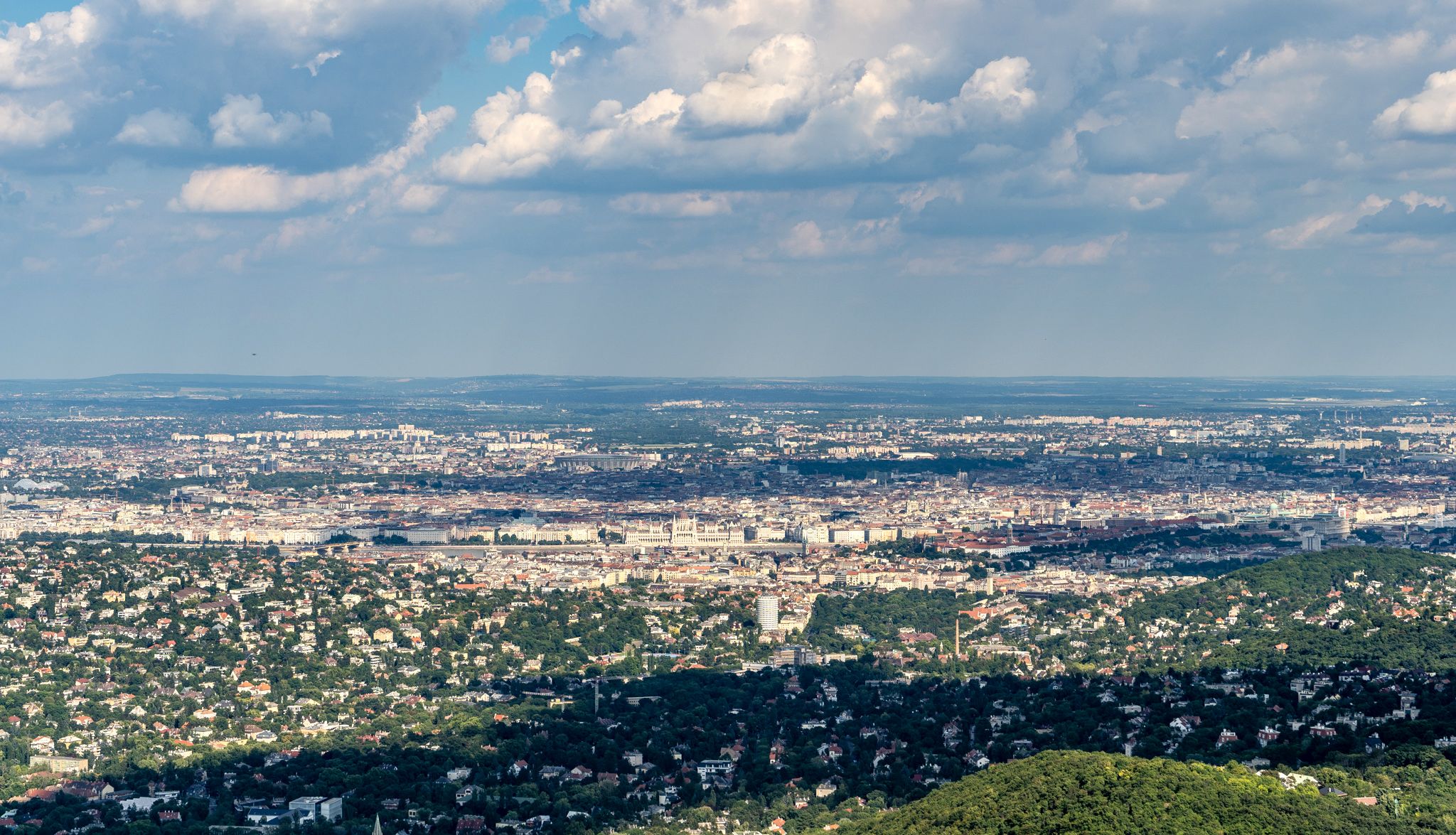
A 75-kilometre radius panorama opens from the lookout (Photo: Balázs Both/pestbuda.hu)
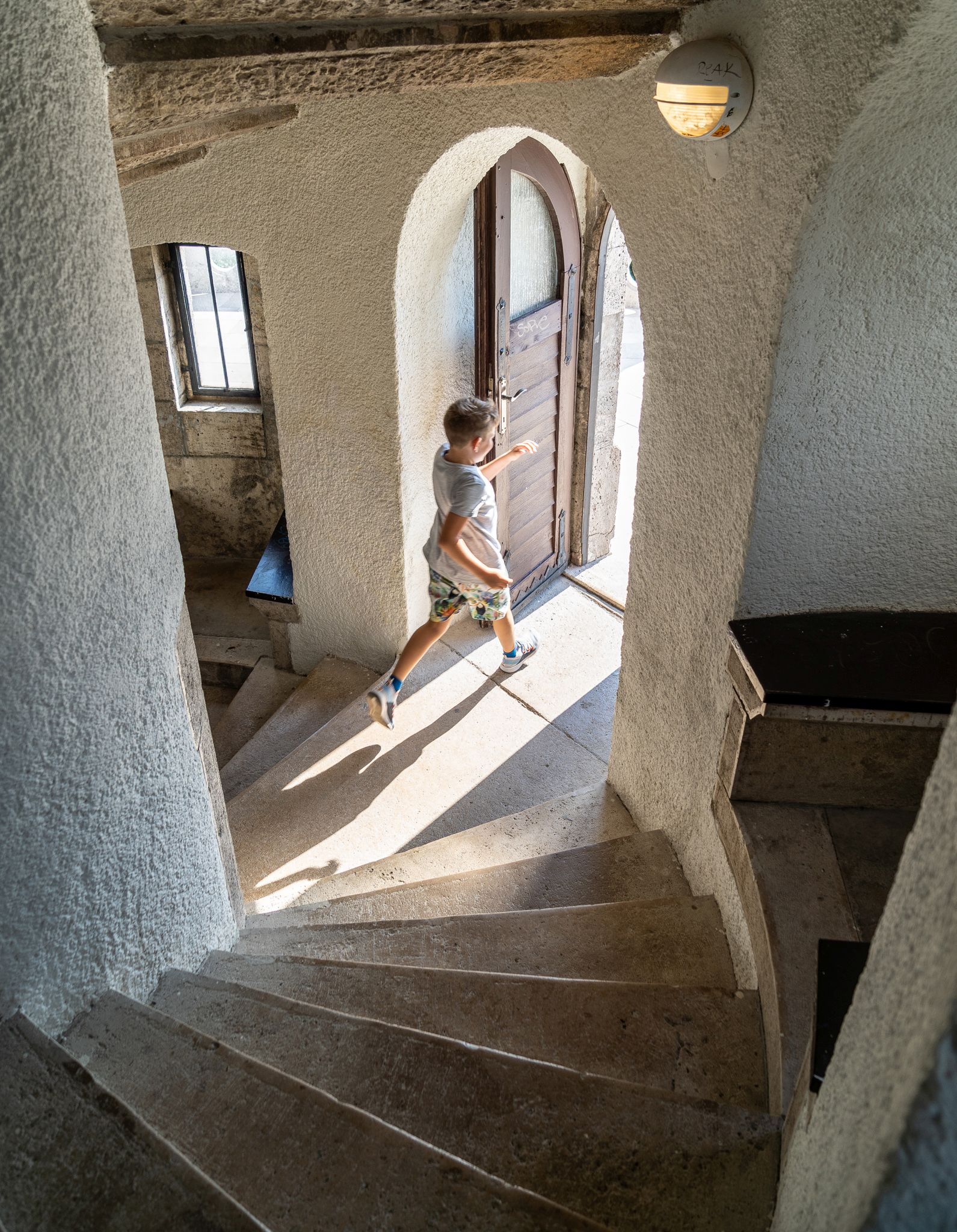
The way down is quicker (Photo: Balázs Both/pestbuda.hu)
 It is worth walking around the building once again from the outside: the ornate column heads between the windows are noteworthy (Photo: Balázs Both/pestbuda.hu)
It is worth walking around the building once again from the outside: the ornate column heads between the windows are noteworthy (Photo: Balázs Both/pestbuda.hu)
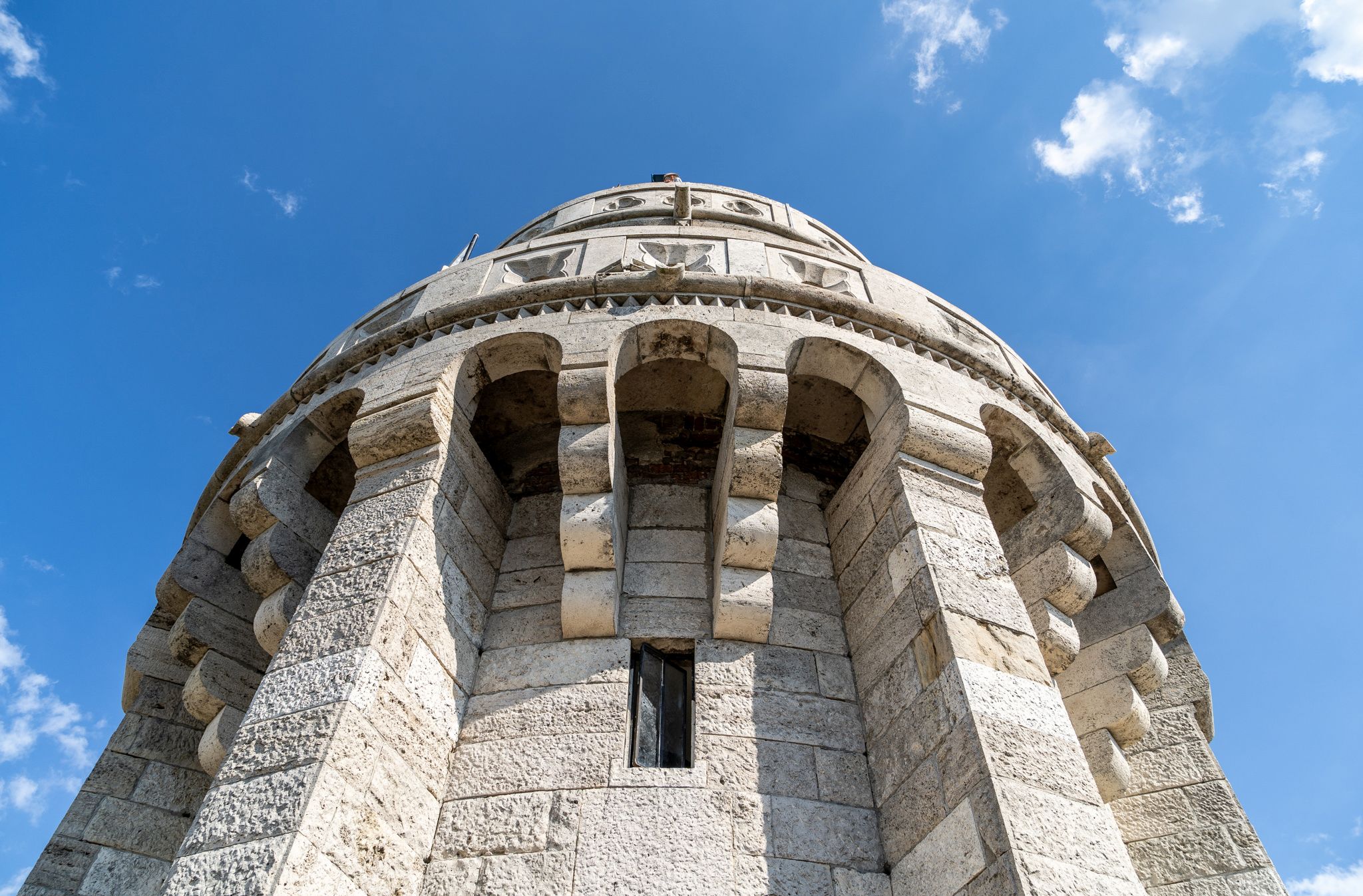
A stunning view (Photo: Balázs Both/pestbuda.hu)
Renewal
In the 1910s, the infrastructure on János Hill was not nearly as developed as it is today. Although Sisi had been on the hill a few decades earlier, she would have been greeted by similar conditions: “Shady, carriageways lead from Svábhegy and Budakeszi Road to the restaurant plateau, which is 50 meters under the hilltop. Varied, well-maintained footpaths lead to the ridge of the mountain, from Svábhegy or Zúgliget, as well as from the Budakeszi country road. Climbing the hill takes an hour and a half, depending on the quality of the road chosen. It would be desirable to set up signposts at the lower end of the footpaths because an uninformed hiker feels lost, and those familiar with the countryside are bombarded with many questions by those who do not know the road.” (Turisták Lapja, 1911, volume 23)
The missing road signs have since been added due to the comprehensive work during which the 12th District local council, together with Pilis Parkerdő Zrt., renovated the lookout and reorganised its surroundings. During the renovations, which began in 2001, life-threatening conditions were repaired. This was necessary because in the years before the fall of socialism, a heavy red star was mounted on top of the lookout, weakening the structure of the building. During the renovation, not only the loosened stones were replaced, but also, among other things, the decorative lighting was modernized, and the woodcutter's hut next to the lookout was also renovated.
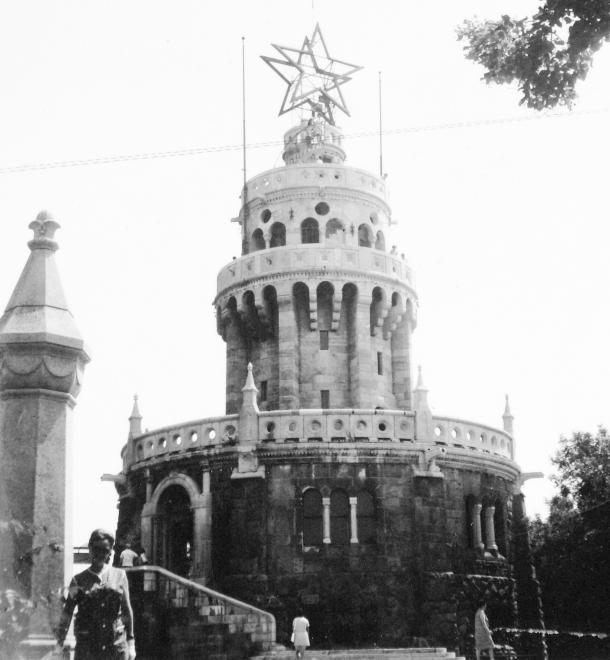
The structure of Elizabeth Tower was severely damaged by the oversized red star (Photo: Fortepan/No.: 11584)
Cover photo: The Elizabeth Lookout Tower on János Hill (Photo: Balázs Both/pestbuda.hu)

